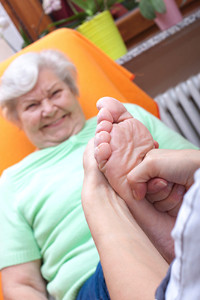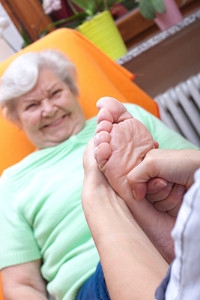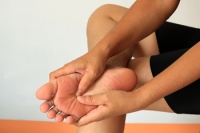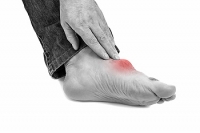
Blog (787)
How to Help Seniors Care for Their Feet
 Elderly people may have difficulty in maintaining proper foot care. This may be a result of being unable to bend down to correctly trim the toenails. Additionally, it may be challenging to wash and dry the feet thoroughly, which may lead to the development of painful foot conditions. Seniors may have trouble seeing any existing wounds on the feet, and the skin may become dry and cracked. It may be beneficial if a caregiver can help older people to properly manage everyday foot care by gently massaging their feet, followed by using a moisturizing lotion. If you have questions about how to take care of elderly feet, it is suggested that you speak to a podiatrist.
Elderly people may have difficulty in maintaining proper foot care. This may be a result of being unable to bend down to correctly trim the toenails. Additionally, it may be challenging to wash and dry the feet thoroughly, which may lead to the development of painful foot conditions. Seniors may have trouble seeing any existing wounds on the feet, and the skin may become dry and cracked. It may be beneficial if a caregiver can help older people to properly manage everyday foot care by gently massaging their feet, followed by using a moisturizing lotion. If you have questions about how to take care of elderly feet, it is suggested that you speak to a podiatrist.
Proper foot care is something many older adults forget to consider. If you have any concerns about your feet and ankles, contact Dr. Kenneth Donovan from Advanced Care Foot and Ankle. Our doctor can provide the care you need to keep you pain-free and on your feet.
The Elderly and Their Feet
As we age we start to notice many changes in our body, but the elder population may not notice them right away. Medical conditions may prevent the elderly to take notice of their foot health right away. Poor vision is a lead contributor to not taking action for the elderly.
Common Conditions
- Neuropathy – can reduce feeling in the feet and can hide many life-threatening medical conditions.
- Reduced flexibility – prevents the ability of proper toenail trimming, and foot cleaning. If left untreated, it may lead to further medical issues.
- Foot sores – amongst the older population can be serious before they are discovered. Some of the problematic conditions they may face are:
- Gouging toenails affecting nearby toe
- Shoes that don’t fit properly
- Pressure sores
- Loss of circulation in legs & feet
- Edema & swelling of feet and ankles
Susceptible Infections
Diabetes and poor circulation can cause general loss of sensitivity over the years, turning a simple cut into a serious issue.
If you have any questions please feel free to contact one of our offices located in Warren, Livingston, and Toms River, NJ . We offer the newest diagnostic and treatment technologies for all your foot and ankle needs.
Are You Suffering From Ingrown Toenails?
Are You Suffering From Ingrown Toenails?
How to Tell If You Have Developed Peripheral Artery Disease
Those with peripheral artery disease, or PAD for short, may experience chronic ischemia, better known as a lack of blood supply. When this occurs, you may experience a dull, cramping pain in the affected area, commonly the feet, when exercising. The pain often stops when resting. This kind of symptom is referred to as claudication. For a proper diagnosis, a podiatrist may suggest taking an ABI, or ankle brachial index. This exam consists of using ultrasound images that will measure the blood pressure in your feet. This type of test is common for diagnosing PAD, and is painless. PAD is likely to develop among adults over the age of 50, and is especially common for those with diabetes. For more information about peripheral artery disease, and to discuss a plan for treatment, we recommend you consult with a podiatrist for professional care.
Peripheral artery disease can pose a serious risk to your health. It can increase the risk of stroke and heart attack. If you have symptoms of peripheral artery disease, consult with Dr. Kenneth Donovan from Advanced Care Foot and Ankle. Our doctor will assess your condition and provide you with quality foot and ankle treatment.
Peripheral artery disease (PAD) is when arteries are constricted due to plaque (fatty deposits) build-up. This results in less blood flow to the legs and other extremities. The main cause of PAD is atherosclerosis, in which plaque builds up in the arteries.
Symptoms
Symptoms of PAD include:
- Claudication (leg pain from walking)
- Numbness in legs
- Decrease in growth of leg hair and toenails
- Paleness of the skin
- Erectile dysfunction
- Sores and wounds on legs and feet that won’t heal
- Coldness in one leg
It is important to note that a majority of individuals never show any symptoms of PAD.
Diagnosis
While PAD occurs in the legs and arteries, Podiatrists can diagnose PAD. Podiatrists utilize a test called an ankle-brachial index (ABI). An ABI test compares blood pressure in your arm to you ankle to see if any abnormality occurs. Ultrasound and imaging devices may also be used.
Treatment
Fortunately, lifestyle changes such as maintaining a healthy diet, exercising, managing cholesterol and blood sugar levels, and quitting smoking, can all treat PAD. Medications that prevent clots from occurring can be prescribed. Finally, in some cases, surgery may be recommended.
If you have any questions, please feel free to contact one of our offices located in Warren, Livingston, and Toms River, NJ . We offer the newest diagnostic and treatment technologies for all your foot care needs.
How to Tell If You Have Developed Peripheral Artery Disease
 Those with peripheral artery disease, or PAD for short, may experience chronic ischemia, better known as a lack of blood supply. When this occurs, you may experience a dull, cramping pain in the affected area, commonly the feet, when exercising. The pain often stops when resting. This kind of symptom is referred to as claudication. For a proper diagnosis, a podiatrist may suggest taking an ABI, or ankle brachial index. This exam consists of using ultrasound images that will measure the blood pressure in your feet. This type of test is common for diagnosing PAD, and is painless. PAD is likely to develop among adults over the age of 50, and is especially common for those with diabetes. For more information about peripheral artery disease, and to discuss a plan for treatment, we recommend you consult with a podiatrist for professional care.
Those with peripheral artery disease, or PAD for short, may experience chronic ischemia, better known as a lack of blood supply. When this occurs, you may experience a dull, cramping pain in the affected area, commonly the feet, when exercising. The pain often stops when resting. This kind of symptom is referred to as claudication. For a proper diagnosis, a podiatrist may suggest taking an ABI, or ankle brachial index. This exam consists of using ultrasound images that will measure the blood pressure in your feet. This type of test is common for diagnosing PAD, and is painless. PAD is likely to develop among adults over the age of 50, and is especially common for those with diabetes. For more information about peripheral artery disease, and to discuss a plan for treatment, we recommend you consult with a podiatrist for professional care.
Peripheral artery disease can pose a serious risk to your health. It can increase the risk of stroke and heart attack. If you have symptoms of peripheral artery disease, consult with Dr. Kenneth Donovan from Advanced Care Foot and Ankle. Our doctor will assess your condition and provide you with quality foot and ankle treatment.
Peripheral artery disease (PAD) is when arteries are constricted due to plaque (fatty deposits) build-up. This results in less blood flow to the legs and other extremities. The main cause of PAD is atherosclerosis, in which plaque builds up in the arteries.
Symptoms
Symptoms of PAD include:
- Claudication (leg pain from walking)
- Numbness in legs
- Decrease in growth of leg hair and toenails
- Paleness of the skin
- Erectile dysfunction
- Sores and wounds on legs and feet that won’t heal
- Coldness in one leg
It is important to note that a majority of individuals never show any symptoms of PAD.
Diagnosis
While PAD occurs in the legs and arteries, Podiatrists can diagnose PAD. Podiatrists utilize a test called an ankle-brachial index (ABI). An ABI test compares blood pressure in your arm to you ankle to see if any abnormality occurs. Ultrasound and imaging devices may also be used.
Treatment
Fortunately, lifestyle changes such as maintaining a healthy diet, exercising, managing cholesterol and blood sugar levels, and quitting smoking, can all treat PAD. Medications that prevent clots from occurring can be prescribed. Finally, in some cases, surgery may be recommended.
If you have any questions, please feel free to contact one of our offices located in Warren, Livingston, and Toms River, NJ . We offer the newest diagnostic and treatment technologies for all your foot care needs.
Signs You May have a Fungal Nail Infection
Fungal nail infections normally form slowly and often are very uncomfortable. There are many signs that can indicate if you have picked up a fungal nail infection. Discoloration of the nail is one giveaway you may have developed this condition. The nail will usually turn yellow, green, black, or white if it has been infected. The nail may also thicken, as well as turn into an abnormal shape, making it hard to trim and care for. Brittleness is another sign of a fungal infection. In certain cases, an infected nail may crumble, or fall off if not treated properly. It is likely to pick up a fungal infection by walking barefoot in environments that are warm and damp. These areas may include locker rooms or communal showers. Not properly washing and drying your feet on a daily basis, as well as not changing your socks and shoes can also be a factor in developing this condition. If you believe you have a fungal nail infection and would like more information on how to treat it, we recommend you consult with a podiatrist for professional care and a proper diagnosis.
For more information about treatment, contact Dr. Kenneth Donovan of Advanced Care Foot and Ankle. Our doctor can provide the care you need to keep you pain-free and on your feet.
Toenail Fungus Treatment
Toenail fungus is a condition that affects many people and can be especially hard to get rid of. Fortunately, there are several methods to go about treating and avoiding it.
Antifungals & Deterrence
Oral antifungal medicine has been shown to be effective in many cases. It is important to consult with a podiatrist to determine the proper regiment for you, or potentially explore other options.
Applying foot powder on the feet and shoes helps keep the feet free of moisture and sweat.
Sandals or open toed shoes – Wearing these will allow air movement and help keep feet dry. They also expose your feet to light, which fungus cannot tolerate. Socks with moisture wicking material also help as well.
If you have any questions please feel free to contact one of our offices located in Warren, Livingston, and Toms River, NJ . We offer the newest diagnostic tools and technology to treat your foot and ankle needs.
Do Your Child’s Feet Hurt?
Do Your Child's Feet Hurt?
How to Check If You Have a Bunion
Bunions are a particularly painful type of foot condition that form on the side of the feet. If you are experiencing foot pain, there are a few steps you can take in order to determine if a bunion is the cause of the discomfort. You may begin by examining your feet to look for a bony lump, or protrusion on the side of your big toe. Next, you’ll want to determine if your big toe is pointing, or leaning towards the rest of your toes. Lastly, you’ll want to check if the skin on the lump is hard, red or swollen. If you notice that all of the above are true to your case, it is very likely that you have a bunion. To relieve the pain of a bunion, it is recommended that you wear shoes wider than normal, ice the affected area on and off, look into wearing bunion pads to prevent further friction with your footwear, and try to keep the weight off of the affected area. Bunions are likely to worsen overtime, which is why we recommend you speak with a podiatrist for professional guidance and a suggested treatment plan.
If you are suffering from bunions, contact Dr. Kenneth Donovan of Advanced Care Foot and Ankle. Our doctor can provide the care you need to keep you pain-free and on your feet.
What Is a Bunion?
A bunion is formed of swollen tissue or an enlargement of boney growth, usually located at the base joint of the toe that connects to the foot. The swelling occurs due to the bones in the big toe shifting inward, which impacts the other toes of the foot. This causes the area around the base of the big toe to become inflamed and painful.
Why Do Bunions Form?
Genetics – Susceptibility to bunions are often hereditary
Stress on the feet – Poorly fitted and uncomfortable footwear that places stress on feet, such as heels, can worsen existing bunions
How Are Bunions Diagnosed?
Doctors often perform two tests – blood tests and x-rays – when trying to diagnose bunions, especially in the early stages of development. Blood tests help determine if the foot pain is being caused by something else, such as arthritis, while x-rays provide a clear picture of your bone structure to your doctor.
How Are Bunions Treated?
- Refrain from wearing heels or similar shoes that cause discomfort
- Select wider shoes that can provide more comfort and reduce pain
- Anti-inflammatory and pain management drugs
- Orthotics or foot inserts
- Surgery
If you have any questions, please feel free to contact one of our offices located in Warren, Livingston, and Toms River, NJ . We offer the newest diagnostic and treatment technologies for all your foot care needs.
How to Check If You Have a Bunion
 Bunions are a particularly painful type of foot condition that form on the side of the feet. If you are experiencing foot pain, there are a few steps you can take in order to determine if a bunion is the cause of the discomfort. You may begin by examining your feet to look for a bony lump, or protrusion on the side of your big toe. Next, you’ll want to determine if your big toe is pointing, or leaning towards the rest of your toes. Lastly, you’ll want to check if the skin on the lump is hard, red or swollen. If you notice that all of the above are true to your case, it is very likely that you have a bunion. To relieve the pain of a bunion, it is recommended that you wear shoes wider than normal, ice the affected area on and off, look into wearing bunion pads to prevent further friction with your footwear, and try to keep the weight off of the affected area. Bunions are likely to worsen overtime, which is why we recommend you speak with a podiatrist for professional guidance and a suggested treatment plan.
Bunions are a particularly painful type of foot condition that form on the side of the feet. If you are experiencing foot pain, there are a few steps you can take in order to determine if a bunion is the cause of the discomfort. You may begin by examining your feet to look for a bony lump, or protrusion on the side of your big toe. Next, you’ll want to determine if your big toe is pointing, or leaning towards the rest of your toes. Lastly, you’ll want to check if the skin on the lump is hard, red or swollen. If you notice that all of the above are true to your case, it is very likely that you have a bunion. To relieve the pain of a bunion, it is recommended that you wear shoes wider than normal, ice the affected area on and off, look into wearing bunion pads to prevent further friction with your footwear, and try to keep the weight off of the affected area. Bunions are likely to worsen overtime, which is why we recommend you speak with a podiatrist for professional guidance and a suggested treatment plan.
If you are suffering from bunions, contact Dr. Kenneth Donovan of Advanced Care Foot and Ankle. Our doctor can provide the care you need to keep you pain-free and on your feet.
What Is a Bunion?
A bunion is formed of swollen tissue or an enlargement of boney growth, usually located at the base joint of the toe that connects to the foot. The swelling occurs due to the bones in the big toe shifting inward, which impacts the other toes of the foot. This causes the area around the base of the big toe to become inflamed and painful.
Why Do Bunions Form?
Genetics – Susceptibility to bunions are often hereditary
Stress on the feet – Poorly fitted and uncomfortable footwear that places stress on feet, such as heels, can worsen existing bunions
How Are Bunions Diagnosed?
Doctors often perform two tests – blood tests and x-rays – when trying to diagnose bunions, especially in the early stages of development. Blood tests help determine if the foot pain is being caused by something else, such as arthritis, while x-rays provide a clear picture of your bone structure to your doctor.
How Are Bunions Treated?
- Refrain from wearing heels or similar shoes that cause discomfort
- Select wider shoes that can provide more comfort and reduce pain
- Anti-inflammatory and pain management drugs
- Orthotics or foot inserts
- Surgery
If you have any questions, please feel free to contact one of our offices located in Warren, Livingston, and Toms River, NJ . We offer the newest diagnostic and treatment technologies for all your foot care needs.












